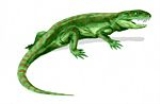
Eothyris
Encyclopedia
Eothyris is an extinct genus of the family Eothyrididae
. It was an insectivorous synapsid
. It was closely related to Oedaleops
.
. It belongs to the Artinskian
age of the Early Permian
.
Eothyrididae
The Eothyrididae were a small group of very primitive, insectivorous synapsids. Only two genera are known, Eothyris and Oedaleops, both from the early Permian of North America...
. It was an insectivorous synapsid
Synapsid
Synapsids are a group of animals that includes mammals and everything more closely related to mammals than to other living amniotes. They are easily separated from other amniotes by having an opening low in the skull roof behind each eye, leaving a bony arch beneath each, accounting for their name...
. It was closely related to Oedaleops
Oedaleops
Oedaleops is an extinct genus of the family Eothyrididae. It was closely related to Eothyris. Like Eothyris, it was probably an insectivore.-Discovery and species:...
.
Discovery and species
Only one species is known, Eothyris parkeyi (Romer), from a single skull, found in the Belle Plains Formation in TexasTexas
Texas is the second largest U.S. state by both area and population, and the largest state by area in the contiguous United States.The name, based on the Caddo word "Tejas" meaning "friends" or "allies", was applied by the Spanish to the Caddo themselves and to the region of their settlement in...
. It belongs to the Artinskian
Artinskian
In the geologic timescale, the Artinskian is an age or stage of the Permian. It is a subdivision of the Cisuralian epoch or series. The Artinskian lasted between 284.4 ± 0.7 and 275.6 ± 0.7 million years ago...
age of the Early Permian
Permian
The PermianThe term "Permian" was introduced into geology in 1841 by Sir Sir R. I. Murchison, president of the Geological Society of London, who identified typical strata in extensive Russian explorations undertaken with Edouard de Verneuil; Murchison asserted in 1841 that he named his "Permian...
.

